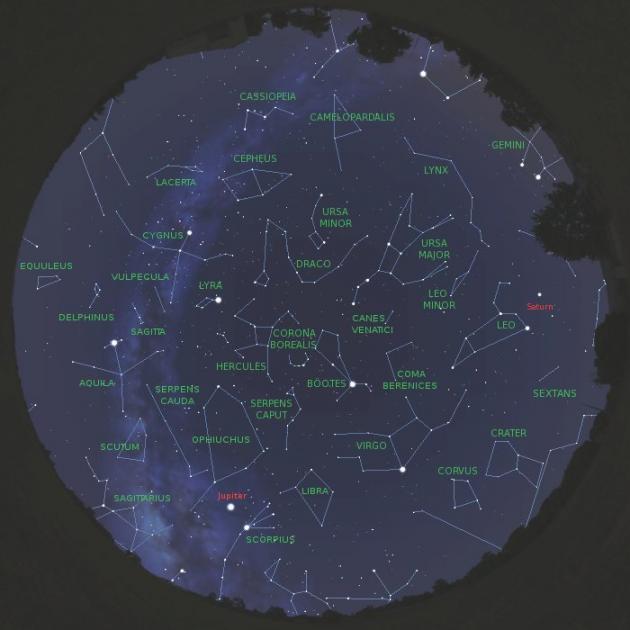- News / Thoughts
- Astronomy Guide
- On This Day
- Reviews
- Bookstore
Astronomical Events for June 2007
06/03/2007On June solstice begins summer season. Thus in this month, we have the shortest night in the year, and for astronomers it'll last for only 3 hours and 7 minutes.
Nevertheless, from sunset until midnight, this month we'll be able to observe four planets: Mercury, Venus, Saturn and Jupiter...
O

Evening sky for the middle of June 2007. at 10:30 PM. The map is valid for northern hemisphere, especially positions near 45 degrees latitude.
The moment which marks the start of the summer on northern hemisphere is when the Sun, on it's apparent path on the sky, reaches the northernmost point from the celestial equator. Then it stops, to begin it's movement towards south, and that's why this moment is called summer solstice (solstice comes from Latin Sol - Sun, and sistere - to stand still). On that particular day, Sun is shining (and thus warming) northern hemisphere under steepest angle. Because of this we have shortest shadows in the year, the longest day, and unfortunately for astronomers, very short night.
Two professions, nautics and astronomy, are very are dependent upon start, and the length of the night, and this is why: when the Sun goes 6° below horizon, you can usually see red sky, and for majority of population, the night has begun. Old sea navigators needed to wait darker sky, so they could see bright stars used for orienting themselves. The sky on the open sea becomes dark enough only when the Sun sets 12° below horizon. For professional astronomers, night begins only when the Sun sets 18° below horizon. Then the sky is as dark as it can be, since even scattering of Suns rays through atmosphere can't reach the night portion of the sky, thus the faintest celestial objects can be seen. Described differences in definition of night are therefore called civil, nautical and astronomical night.
It is interesting to note that on summer solstice (ie. the beginning of the summer season), which on this year will be on June 21st, at 18:06 UT, astronomical night will last only 03:07 hours. Of course, amateur astronomers don't need to wait real astronomical night, but they'll be able to recognize first constellation patterns only after 22:30 in the evening. Planets will be observable at that time as well...
You can spot Mercury near horizon right after the Sun sets. Unfortunately, the only thing you can see is it's position, which is about between Sun and planet Venus.
Venus will on Saturday, June 9th, reach it's greatest elongation (apparent distance from the Sun when watching from the Earth) with remarkable arc length of 45°. Glowing so high and so bright in the evening sky, it has dazzled many bystanders. Soon enough it'll start its path closer to the Suns glare, where it'll disappear in the August, only to reappear in the early morning shortly after.
Saturn is still on the evening sky, giving us breathtaking sights of it's ring system.
Jupiter, which skims pretty close to horizon this year, will on June 6th be in opposition, when it is positioned directly on the opposite side of the Sun. When observing Jupiter, the easiest sight are changing positions of its four brightest satellites. Every now and then you'll be able to spot the shadow of a satellite pass across Jupiters bright disk, but not so often you can catch passing of two or even three of them at the same time. This month you can observe crossings of two satellite shadow on June 9th, at 09:18 UT, and on June 16th, at 11:48 UT. Most probably you'll be able to spot only one occurrence because of daylight.
Depending on your time zone, this month Moon will be full two times. Moon phases for June 2007 are:
- Full Moon - June 1. 01:04 UT
- Last Quarter - June 8. 11:43 UT
- New Moon - June 15. 03:13 UT
- First Quarter - June 22. 13:15 UT
- Full Moon - June 30. 13:49 UT